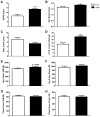Habitual physical activity levels are associated with performance in measures of physical function and mobility in older men
- PMID: 20738436
- PMCID: PMC2945416
- DOI: 10.1111/j.1532-5415.2010.03012.x
Habitual physical activity levels are associated with performance in measures of physical function and mobility in older men
Abstract
Objectives: To determine whether objectively measured physical activity levels are associated with physical function and mobility in older men.
Design: Cross-sectional.
Setting: Academic research center.
Participants: Eighty-two community-dwelling men aged 65 and older with self-reported mobility limitations were divided into a low-activity and a high-activity group based on the median average daily physical activity counts of the whole sample.
Measurements: Physical activity according to triaxial accelerometers; physical function and mobility according to the Short Physical Performance Battery (SPPB), gait speed, stair climb time, and a lift-and-lower task; aerobic capacity according to maximum oxygen consumption (VO(2) max); and leg press and chest press maximal strength and peak power.
Results: Older men with higher physical activity levels had a 1.4-point higher mean SPPB score and a 0.35-m/s faster walking speed than those with lower physical activity levels. They also climbed a standard flight of stairs 1.85 seconds faster and completed 60% more shelves in a lift-and-lower task (all P<.01); muscle strength and power measures were not significantly different between the low- and high-activity groups. Correlation analyses and multiple linear regression models showed that physical activity is positively associated with all physical function and mobility measures, leg press strength, and VO(2) max.
Conclusion: Older men with higher physical activity levels demonstrate better physical function and mobility than their less-active peers. Moreover, physical activity levels are predictive of performance in measures of physical function and mobility in older men. Future work is needed to determine whether modifications in physical activity levels can improve or preserve physical performance in later life.
© 2010, Copyright the Authors. Journal compilation © 2010, The American Geriatrics Society.
Conflict of interest statement
Figures

References
-
- Jette AM, Pinsky JL, Branch LG, et al. The Framingham Disability Study: Physical disability among community-dwelling survivors of stroke. J Clin Epidemiol. 1988;41:719–726. - PubMed
-
- Tinetti ME, Speechley M, Ginter SF. Risk factors for falls among elderly persons living in the community. N Engl J Med. 1988;319:1701–1707. - PubMed
-
- Studenski S, Perera S, Wallace D, et al. Physical performance measures in the clinical setting. J Am Geriatr Soc. 2003;51:314–322. - PubMed
-
- Wilson IB, Cleary PD. Linking clinical variables with health-related quality of life. A conceptual model of patient outcomes. JAMA. 1995;273:59–65. - PubMed
Publication types
MeSH terms
Grants and funding
LinkOut - more resources
Full Text Sources
Medical

